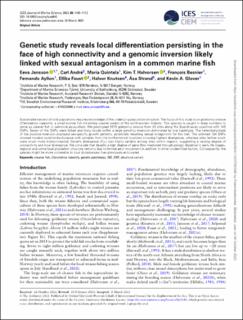| dc.contributor.author | Jansson, Eeva | |
| dc.contributor.author | André, Carl | |
| dc.contributor.author | Quintela, Maria | |
| dc.contributor.author | Halvorsen, Kim Aleksander Tallaksen | |
| dc.contributor.author | Besnier, Francois | |
| dc.contributor.author | Ayllon, Fernando | |
| dc.contributor.author | Faust, Ellika | |
| dc.contributor.author | Knutsen, Halvor | |
| dc.contributor.author | Strand, Åsa | |
| dc.contributor.author | Glover, Kevin Alan | |
| dc.date.accessioned | 2023-10-05T11:17:57Z | |
| dc.date.available | 2023-10-05T11:17:57Z | |
| dc.date.created | 2023-09-14T10:41:23Z | |
| dc.date.issued | 2023 | |
| dc.identifier.citation | ICES Journal of Marine Science. 2023, 80 (4), 1103-1112. | en_US |
| dc.identifier.issn | 1054-3139 | |
| dc.identifier.uri | https://hdl.handle.net/11250/3094471 | |
| dc.description.abstract | Sustainable harvest of wild populations requires knowledge of the underlying population structure. The focus of this study is on goldsinny wrasse (Ctenolabrus rupestris), a small marine fish inhabiting coastal waters of the north-eastern Atlantic. This species is caught in large numbers to serve as cleaner fish in salmonid aquaculture. We genotyped 2073 goldsinny wrasse from 43 sites along the Scandinavian coastline with 143 SNPs. Seven of the SNPs were linked and likely reside within a large genomic inversion dominated by one haplotype. The heterokaryotype of the putative inversion displayed sex-specific growth patterns, potentially resolving sexual antagonism for this trait. The unlinked 134 SNPs showed modest isolation-by-distance with samples from the northernmost locations showing highest divergence, whereas sites farther south were much more interconnected. Genetic divergence (FST) was highly variable among sites within regions, suggesting a varying degree of connectivity and local divergence. We conclude that despite a high degree of gene-flow mediated through pelagic dispersal in early life stages, regional and some local population structure remains due to limited adult movement in addition to other unidentified factors. Consequently, the species might be more vulnerable to local disturbances than previously anticipated. | en_US |
| dc.language.iso | eng | en_US |
| dc.title | Genetic study reveals local differentiation persisting in the face of high connectivity and a genomic inversion likely linked with sexual antagonism in a common marine fish | en_US |
| dc.title.alternative | Genetic study reveals local differentiation persisting in the face of high connectivity and a genomic inversion likely linked with sexual antagonism in a common marine fish | en_US |
| dc.type | Peer reviewed | en_US |
| dc.type | Journal article | en_US |
| dc.description.version | publishedVersion | en_US |
| dc.source.pagenumber | 1103-1112 | en_US |
| dc.source.volume | 80 | en_US |
| dc.source.journal | ICES Journal of Marine Science | en_US |
| dc.source.issue | 4 | en_US |
| dc.identifier.doi | 10.1093/icesjms/fsad042 | |
| dc.identifier.cristin | 2175003 | |
| cristin.ispublished | true | |
| cristin.fulltext | original | |
| cristin.qualitycode | 2 | |
